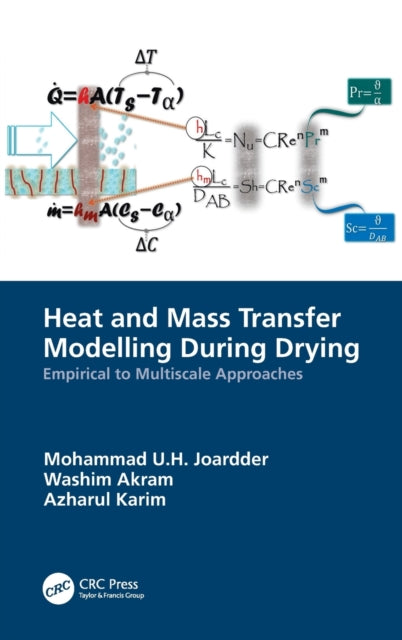Mohammad U.H. Joardder,Washim Akram,AzharulKarim
Heat and Mass Transfer Modelling During Drying: Empirical to Multiscale Approaches
Heat and Mass Transfer Modelling During Drying: Empirical to Multiscale Approaches
YOU SAVE £8.64
- Condition: Brand new
- UK Delivery times: Usually arrives within 2 - 3 working days
- UK Shipping: Fee starts at £2.39. Subject to product weight & dimension
Bulk ordering. Want 15 or more copies? Get a personalised quote and bigger discounts. Learn more about bulk orders.
Couldn't load pickup availability
- More about Heat and Mass Transfer Modelling During Drying: Empirical to Multiscale Approaches
Conventional dryers use random heating, leading to excess energy consumption and low-quality dried products. Heat and mass transfer modelling is essential for designing efficient drying systems. This book discusses empirical to multiscale modelling techniques to predict energy consumption and understand the physics of drying porous materials. It covers material properties, mathematical modelling, numerical solution approaches, and potential challenges.
Format: Hardback
Length: 200 pages
Publication date: 30 September 2021
Publisher: Taylor & Francis Ltd
Most conventional dryers employ random heating to dry a wide range of materials without taking into account their thermal sensitivity and energy requirements for drying. As a result, excessive energy consumption is inevitable to achieve a low-quality dried product. By conducting proper heat and mass transfer modelling prior to designing a drying system for specific food materials, these problems can be overcome.
Heat and Mass Transfer Modelling During Drying: Empirical to Multiscale Approaches delves into the challenge of predicting energy consumption in terms of heat and mass transfer simulation. A comprehensive mathematical model can offer valuable insights into the underlying transport phenomena within the materials during drying. However, drying porous materials like food poses one of the most complex problems in the engineering field, characterized by its multiscale nature. From a modelling perspective, heat and mass transfer phenomena can be predicted using both empirical and multiscale modelling approaches. Multiscale simulation methods, on the other hand, provide a thorough understanding of the physics involved in drying food materials.
KEY FEATURES:
• Comprehensive discussion on material properties relevant for drying phenomena
• In-depth exploration of the underlying physics of drying using conceptual visual content
• Appropriate formulation of mathematical modelling from empirical to multiscale approaches
• Numerical solution approaches to mathematical models
• Presentation of possible challenges of different modelling strategies and potential solutions
The primary objective of this book is to discuss the implementation of various modelling techniques, spanning from empirical to multiscale, in order to comprehend the heat and mass transfer phenomena that occur during drying of p. By leveraging these modelling approaches, researchers and practitioners can develop more efficient and effective drying systems for a wide range of food materials, ensuring optimal quality and energy consumption.
Weight: 567g
Dimension: 229 x 152 (mm)
ISBN-13: 9781138624023
This item can be found in:
UK and International shipping information
UK and International shipping information
UK Delivery and returns information:
- Delivery within 2 - 3 days when ordering in the UK.
- Shipping fee for UK customers from £2.39. Fully tracked shipping service available.
- Returns policy: Return within 30 days of receipt for full refund.
International deliveries:
Shulph Ink now ships to Australia, Belgium, Canada, France, Germany, Ireland, Italy, India, Luxembourg Saudi Arabia, Singapore, Spain, Netherlands, New Zealand, United Arab Emirates, United States of America.
- Delivery times: within 5 - 10 days for international orders.
- Shipping fee: charges vary for overseas orders. Only tracked services are available for most international orders. Some countries have untracked shipping options.
- Customs charges: If ordering to addresses outside the United Kingdom, you may or may not incur additional customs and duties fees during local delivery.


